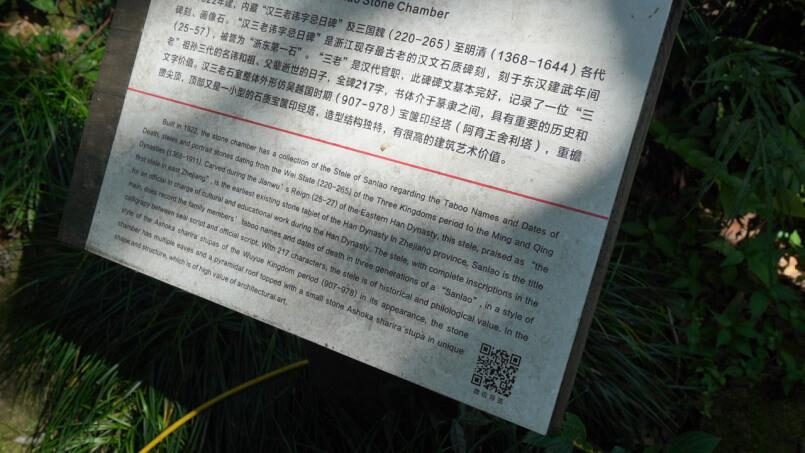Time Imprint: The 3D Digital Resurrection Journey of The Han Sanlao Stone Chamber
10/18/24
Nestled within the lush surroundings of the Xiling Seal Society in Hangzhou, the Han Sanlao Stone Chamber stands silently, recounting tales of a millennium. Each stele within serves as a testament to history, with every inscription bearing the weight of cultural heritage. However, the passage of time and environmental changes pose preservation challenges to these precious relics. At this critical juncture, the advent of digital technology has heralded a new era in the conservation efforts of the Han Sanlao Stone Chamber’s cultural heritage.
I. Project Background
The Han Sanlao Stone Chamber, located to the south of the Guanyue Building within the Xiling Seal Society in Hangzhou, adjacent to the Hot Spring, was initially constructed in 1921. It houses the oldest extant stone stele in Zhejiang Province, the “Han Sanlao Taboo Inscription Stele,” along with other valuable stone inscriptions from the Han and Wei dynasties to the Ming and Qing periods. The “Han Sanlao Taboo Inscription Stele” is approximately 1900 years old and is the most ancient surviving stone inscription in Han script, recording the names and taboo dates of a “Sanlao” official and his family, offering immense historical and philological research value.
The architecture of the stone chamber is distinctive, modeled after the Wu-Yue style Patriotic Pagoda (Ayuwang Relic Pagoda). It features a double-eaved, pointed roof, with a small stone Patriotic Pagoda adorning the top. This design holds significant artistic value in the realm of architectural art. The chamber is adorned with numerous couplets and horizontal inscribed boards. The horizontal board reading “Han Sanlao Stone Chamber” above the door was inscribed by Feng Xu in 1923, while the couplets on the stone walls attest to the profound historical impact. The Han Sanlao Stone Chamber is not only a repository of cultural relics but also a historical testament imbued with cultural heritage and patriotic sentiment.
II. Technical Methods: Application of iReal 2E and KSCAN-Magic in the Digitization of Cultural Relics Preservation
In the project to advance the 3D digital monitoring and conservation of the ancient architecture and inscriptions of the Han Sanlao Stone Chamber, ScanTech, in collaboration with Zhejiang University, has utilized the iReal 2E professional 3D scanner and the KSCAN-Magic laser 3D scanner. These advanced pieces of equipment have been employed to conduct detailed 3D scanning work, catering to different scanning needs and ensuring the precise capture and digital reproduction of the stone steles.
iReal 2E Professional 3D Scanner: Rapid Capture of the Stele’s Features
The iReal 2E has distinguished itself in the project with its immediate scanning capability, swiftly conducting a comprehensive scan of the Han Sanlao Stone Chamber’s overall structure. Without the need for markers, the device significantly enhances scanning efficiency, saving valuable time for the conservation of the stone steles.
Key advantages of the iReal 2E during the scanning process include:
- Efficient 3D Data Acquisition: With a wide Field of View (FoV) measuring 580 mm x 550 mm and color scanning capability, the iReal 2E rapidly collects 3D data while capturing complete color information, ensuring the authentic restoration of the stele’s appearance.
- Infrared VCSEL Structured Light Technology: This technology provides exceptional adaptability to various lighting conditions. Even in low-light environments, the device can perform scanning tasks with stability, ensuring the accuracy and reliability of the scanning data.
KSCAN-Magic Laser 3D Scanner: Meticulous Restoration of Stone Carving Details
The high-precision laser 3D scanning technology employed by the KSCAN-Magic brings to light the inscriptions, carving details, and weathering marks on the stele, opening a dialogue with the history of the “Three Elders” officials and their families for researchers. The device’s features provide solid technical support for the project’s success:
- Lightweight and Portable: The device offers exceptional field adaptability, unaffected by vibrations, temperature, humidity, and other environmental factors, ensuring smooth on-site scanning.
- High Precision and Resolution: The KSCAN-Magic provides scanning accuracy of up to 0.020 mm and an ultra-high resolution of 0.02mm, accurately replicating the surface texture details of the stone carvings and creating an exact digital replica of the cultural heritage.
- Blue Cross Laser Scanning Mode: This design allows the KSCAN-Magic to flexibly handle the various complex structures and surface characteristics of the Han Sanlao Stone Chamber.
III. Conclusion: Digital Empowerment Breathes New Life into Cultural Relics
Through this 3D scanning project, the steles of the Han Sanlao Stone Chamber have been preserved in digital form for eternity. Not only does this provide new insights for the conservation of cultural relics, but it also allows a wider audience to experience the historical depth carried by these steles, transcending the limitations of time and space through the internet. Empowered by digital technology, the steles of the Han Sanlao Stone Chamber have been revitalized, continuing to tell their stories. We, in turn, will continue our efforts in the digital preservation of cultural relics, allowing the light of history to shine upon the future.
Related Articles
View Our Product
















